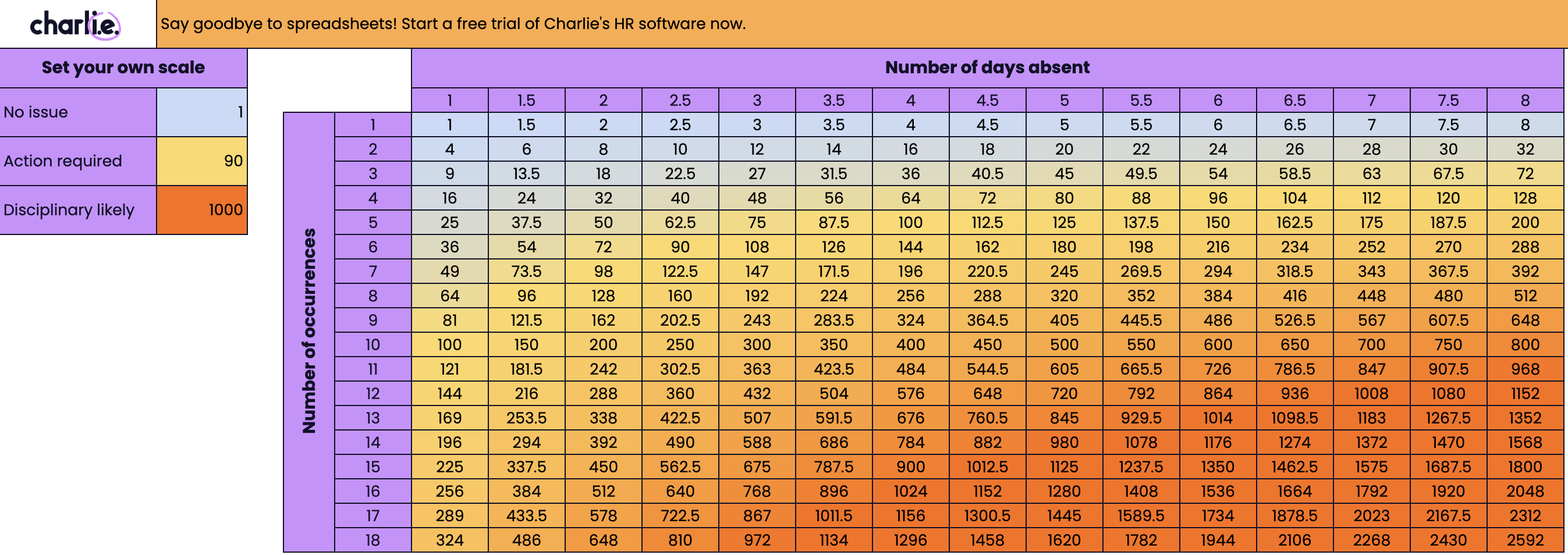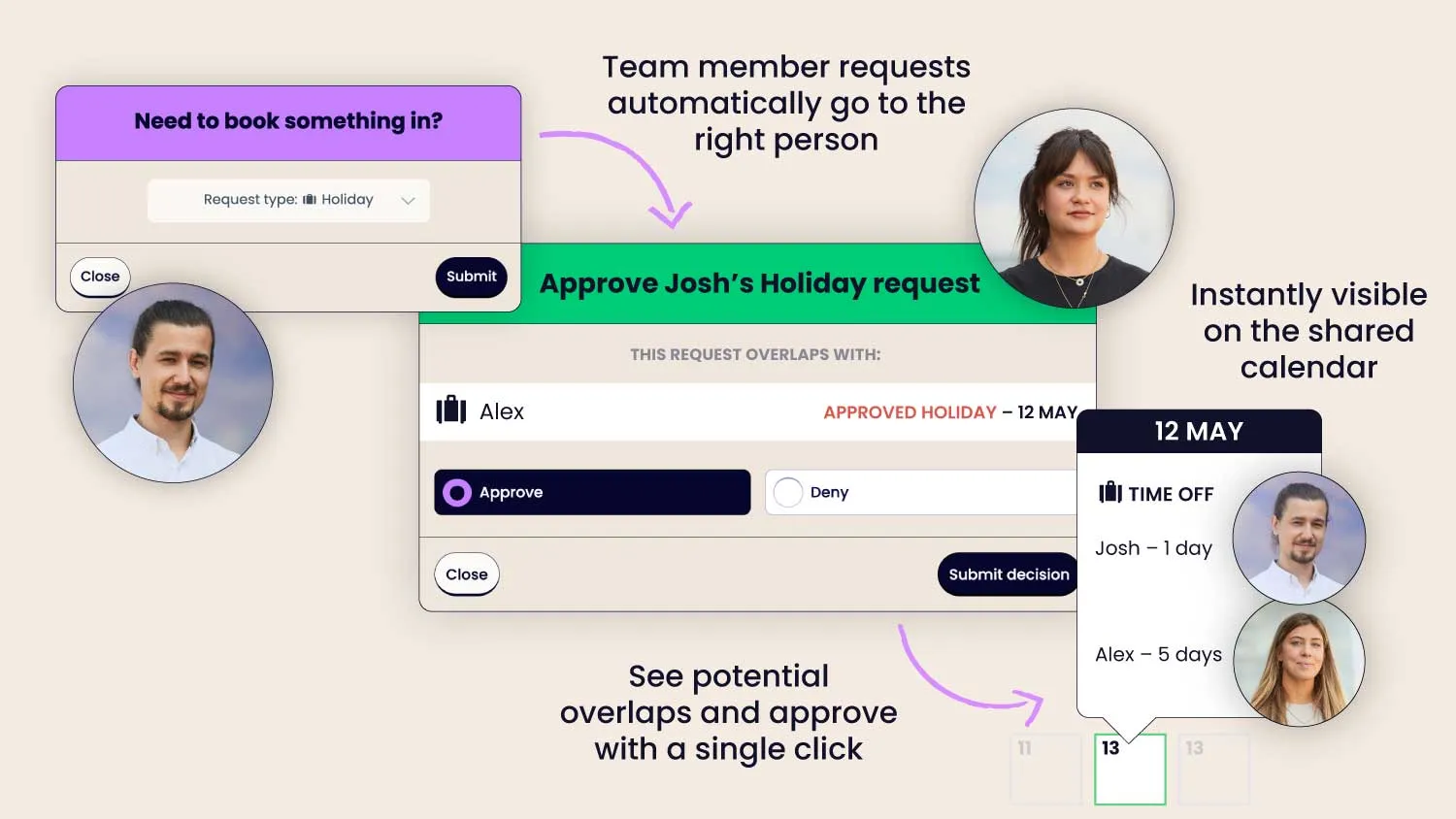
We all want our employees to be working at their best, but it’s inevitable that they’ll need to take time off at some point. While recording staff absences can be simple, it’s often harder to understand the impact they have on your business. That’s why some companies use methods like the Bradford Factor to understand staff absences.
In this guide, we’ll explore what the Bradford Factor is, how it’s calculated, and why companies use it. We’ll also introduce you to a better and more fair way to tackle staff absences.
What is the Bradford Factor?
The Bradford Factor, also known as the Bradford formula or Bradford index, is a simple mathematical formula that can help companies understand and visualise their unplanned absence rates. According to the CIPD, the Bradford Factor takes its name from a research paper published by the Bradford University School of Management in the 1980s.
The Bradford Factor takes the stance that longer absences are less disruptive than short term but more frequent absences, even if it amounts to the same amount of days in total. The formula applies this weighting to give employers an impact score that they can compare across employees.
How do you calculate a Bradford score?
The Bradford is calculated with a simple formula:
S x S x D = Bradford Factor score
In this formula:
-
S represents the total number of spells of absence (or instances of absence) over a given timeframe — usually over a 52-week period.
- D stands for the total number of days of absence over that same timeframe.
Say a staff member gets the flu and takes two sick days. Later that year, they get food poisoning and need to take a further five more days off work. In this instance, the formula would look like this:
2 x 2 x 7 (2+5) = 28
What is an acceptable Bradford factor score?
Different companies assess Bradford Factor scores in different ways. Some employers define specific ‘trigger points’ which, once met over a set period, are then flagged to managers. Where those trigger points lie, and what action is actually triggered, is entirely up to the company.
One Bradford Factor trigger point could lead to an informal chat with a line manager, while a higher score might prompt a more formal disciplinary process including a verbal warning, written warning, or further disciplinary action.
To make it easy for you to visualise when you might want to take action on an employee’s Bradford Factor score, we’ve created this table:

You can also download our Bradford Factor spreadsheet and save it somewhere for future reference. It’s editable too, so you can customise it with your own scale or trigger points and watch as the heatmap updates in real-time.
Is the Bradford Factor useful?
The actual, real-world usefulness of the Bradford Factor is a point of contention within HR circles. Some HR leaders maintain that it’s helpful, especially in large organisations. Others disagree with the way that it applies the same formula to everyone, regardless of the type of absence.
An advantage of the Bradford Factor is that it’s easy to calculate. With our Bradford Score calculator above, you can quickly figure out all of your employees’ scores and store that information on a spreadsheet. From there, you can compare data, and decide whether you need to take any action.
The Bradford Factor applies to all employees and treats all absences as the same, which some may argue is a fair way of handling staff absenteeism. Others, including the team here at Charlie, feel that this actually isn’t fair. It promotes equality instead of equity, which is what we should be striving for.
By applying the same weighting no matter the reason for absence, the Bradford Factor disadvantages people in specific groups. This includes people with chronic illnesses or medical conditions, people with disabilities, those on long-term sick leave or unpaid leave, carers, and individuals that would benefit from support (not punishment) to attend work more regularly.
We believe that the best way to address staff absence rates is to approach it proactively, on a personal basis, and to avoid “punishment” for unexpected time off. While the Bradford Factor can help you visualise and compare absence data, it’s not a fair or effective way to manage staff absenteeism, and can often have a negative impact on the people that need the most support.
What is the alternative to the Bradford Factor?
Rather than relying too heavily on the Bradford Factor, a good HR strategy takes a more considered view of staff absences. The goal is not to punish people for being absent, but to create an environment where employees both don’t want, or need, to miss time from work — unless it’s completely unavoidable.
As we said earlier, it could be that recurring, short-term absences are being caused by something that the employer can help with — something that a simple return-to-work interview could uncover. Maybe the employee is a new parent or a carer, and their absences would decrease if they could work more flexibly.
Charlotte Philip, Human Resources Consultant
“Rather than relying on the Bradford Factor too heavily, a more effective, personal and kind alternative is return-to-work interviews, whereby you speak to your team members upon their return to work about their situation and find out if they need any support or help from the business. This approach is also more effective in identifying and exerting pressure on malingerers."
As well as hosting return-to-work interviews, you can also:
- Create and share a clear attendance or absence policy
- Host regular check-ins between individuals and their managers
- Promote employee wellbeing and a positive work-life balance
- Offer flexibility in working arrangements and routines
- Promote transparency and openness
- Ask for feedback regularly
- Invite employees to discuss matters or seek support when they need to
- Provide different ways for an employee to ask for help or support
Taking these steps allows you to understand each situation individually, treat everyone with equity, and create a better working environment for every employee.
Manage absences more proactively with CharlieHR
Whether you decide to use the Bradford Factor or not, there’s one thing that’ll help you streamline your absence management: the right HR software.
Charlie can help you manage HR tasks, including staff absences, in a more organised and effective way — ideal if you’re juggling HR with another role.
With Charlie you can:
- Automatically record, approve, and deny absences and time off in one secure platform
- See who is ill or away with notifications or via Slack
- Pull in-depth reports on time off to oversee holiday use and track absences
- Use reports to identify absence trends and work together to support your employee
- Introduce customisable leave types (at Charlie we’ve introduced “personal days”)
- Get notified when a team member hasn’t been using their holiday, so you can encourage them to take a break
- Share your employee handbook and policies so it’s clear what your approach to time off is

By freeing up your time from needless admin, you’ll be able to spend more of your day talking to your employees and finding out what they need to perform at their best. And it’s not just time-off management, either — you can use Charlie for all your HR needs.
If you’re ready to tackle your HR chaos and embrace a more effortless approach to HR, take a free trial of Charlie.
Make HR effortless with Charlie
Book a demo

Learn how to cut HR admin

Get any question answered

Zero commitment
Bradford score FAQs

In a nutshell, the answer to the question is ‘yes’ — but only if the trigger points you set and the consequences that they trigger are ‘reasonable’. There’s no cut-and-paste solution to decide what constitutes a reasonable trigger point in this scenario, so you’ll need to use your own discretion.
When setting your Bradford Factor trigger points, ask yourself what scenarios might arise from that policy. Would you feel comfortable defending that policy? If not, perhaps the triggers are too severe and should be reconsidered.

The Bradford Factor should only calculate unplanned or sickness leave. You shouldn’t include any absences related to statutory leave, like maternity or paternity leave.

In most companies, the Bradford Factor will reset every year. You can choose to align this with the traditional company year every April, at the start of the year on 1st January, or on another date, as long as it’s clear to your employees when this is.
The good thing is you can also make this happen in our software as it can be tailored to your different policies and holiday year.

The Bradford score should only include days which the employee would usually work. This means the score wouldn’t include weekends if your employee works a typical Monday-Friday 9-5, but if their shift pattern is a Wednesday-Sunday then it would.

Every company owner will have a slightly different opinion on what an acceptable level of sickness absence is. Typically, a rate of 1-2% is considered “good”. It’s important to keep in mind that employees may experience unexpected absences for a wide range of reasons, and some people may be more likely to become unwell or be unavailable to work than others.

Our Bradford Factor calculator gives you a quick and easy way to get one view on the staff absence rates and trends at your company. For other useful resources, like a holiday entitlement calculator, explore our HR tools section.









